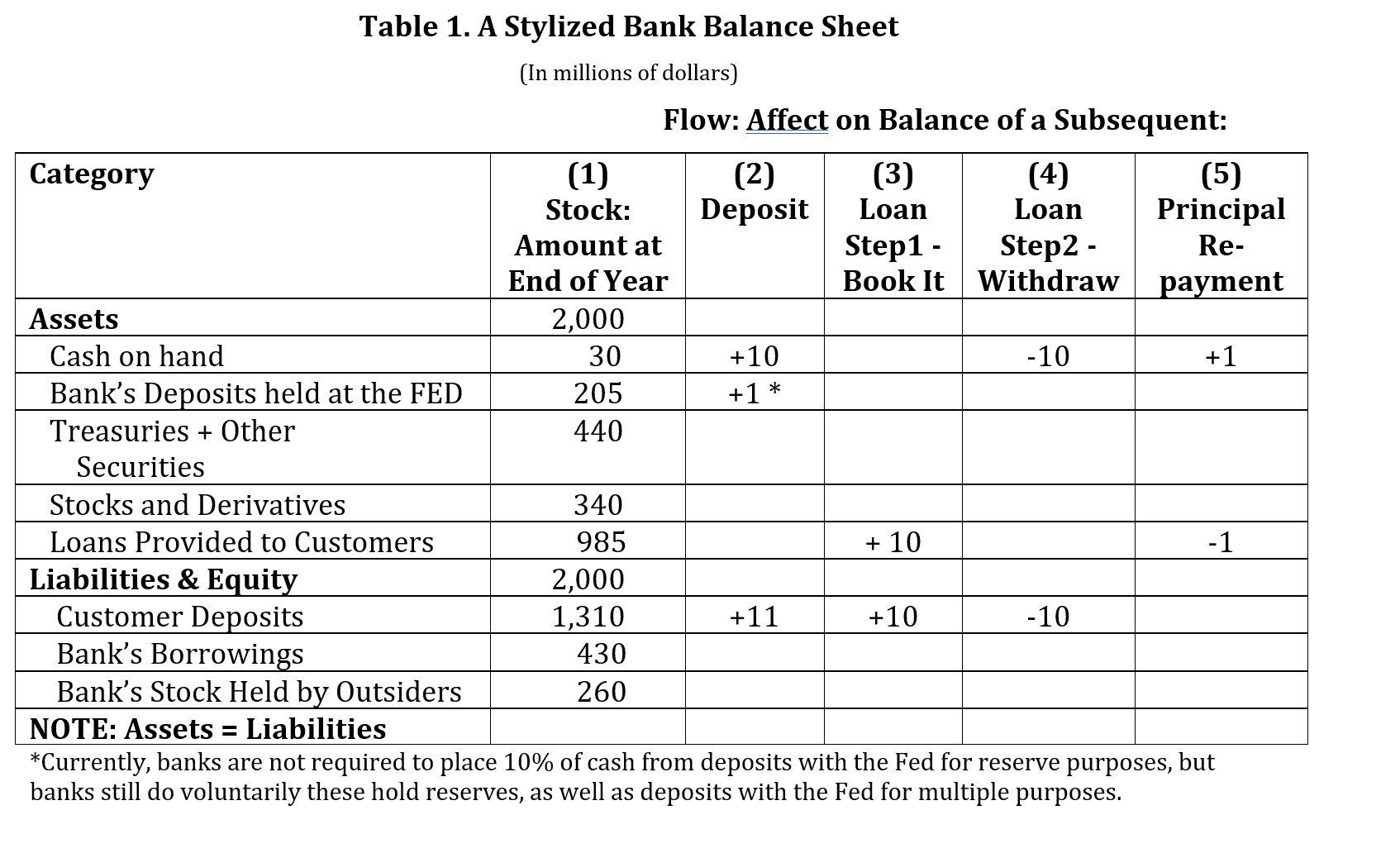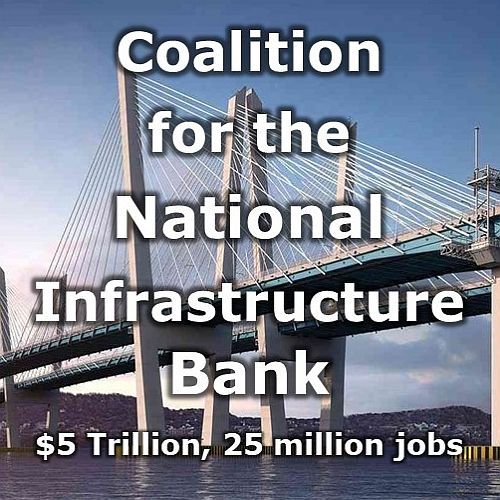Q: Exactly where does the money come from that the NIB gives out in loans?
A: The same as any other deposit money bank (DMB), the NIB creates money (deposits) each time that it provides a loan (see Annex I). Also like DMBs, the NIB recirculates deposits to and from the banking system. Each major operation is summarized as follows. The effect on the bank’s books appear below:
- A customer opens a general deposit of $11 with the NIB, brought in from another bank. The NIB can now lend out $10 of the cash from that deposit, but will maintain $1 in its cash account as a reserve, in case some other depositor wishes to withdraw.
- In Step 1 of a loan, a borrower requests an infrastructure loan of $10. The NIB approves and books the loan as an asset, then, as part of its accounting software, creates an equivalent dollar deposit in the borrower’s name (an NIB liability) ready for use.
- In Step 2 of a loan, when the borrower withdraws the newly created deposit, say by writing a check payable at another bank, the NIB uses cash from its cash account to settle the cleared check.
- If the cash account becomes low because not enough general deposits have come in to clear checks from loans issued, the NIB can get more cash by borrowing from other banks, or issuing its own NIB bonds.
| NIB Books | General Deposit | Step 1:Loan Booking | Step 2: Borrower Withdraws | NIB Issues a Bond |
|---|---|---|---|---|
| Asset: Cash | + $11 | - $10 | + $5 | |
| Asset: Loans | +$11 | + $10 | ||
| Liability: Deposits | +$10 | - $10 | ||
| Liability: NIB Bond Issues | + $5 |
Annex I – How the National Infrastructure Bank (NIB) Creates and Makes Money
Last Updated: June 30, 2021
This Annex provides a fuller explanation of how the National Infrastructure Bank (NIB) will take in deposits (and raise capital), and then provide money, in exchange for loans to finance infrastructure projects. Also see Flowchart below.
How Borrowers Account for Loans – The explanation first requires a little knowledge of how borrowers and lenders account for loans on their books. When any entity (including the US Government) borrows money, the lender hands over cash, and the borrower hands over a loan note of equal value (in Government’s case, a Treasury Security). In their respective accounts, the borrower (Government) books the loan as a Liability on its books, and the lender books the loan (Treasury) as an Asset on its books.
How Lenders Account for Loans – Banks, similarly, book the loans they provide as Assets – usually forming the largest asset class on their books (see Table 1, column 1, below). Banks also book any cash they may receive, or Treasuries or stocks they may own, as Assets. Most transactions flow through a bank’s cash accounts. Cash goes up when the bank receives interest and principal repayments on loans, or when it takes in deposits. Cash goes down when the bank pays its workers and other overhead. If banks have too much cash on hand not earning interest, they may exchange the cash for interest bearing Treasuries. Banks typically earn their money on the difference between interest rates charged to borrowers, and those paid to depositors.
The main difference between a bank’s Balance Sheet, and that of any other corporation, is that banks are chartered under US National Banking Acts to take in deposits, which normally form their largest Liability.

Money Creation – Commercial banks create money when they give out loans. Some 90% of the U.S. money supply is created by banks in this way (the Federal Reserve creates the remaining 10% when it issues (creates) money to buy Treasuries from banks, thus pushing newly created money into the banking system).
Economists are divided on the theories describing how banks create money, but have boiled them down to three:[1] (1) The currently prevailing financial intermediation theory says that banks collect deposits and lend these out, [2] except for a 10% cash reserve they must hold at the FED (just in case an unusual number of depositors ask to withdraw their money at once; although this requirement is currently suspended, banks still do prudentially hold them). (2) The older fractional reserve theory says that while individual banks do not create money, the banking system as a whole is able to do so through the process of multiple deposit expansion, called “fractional reserve banking”. And (3) the credit theory of money, outlined by Joseph Schumpeter a century ago, holds that each individual bank creates money through its accounting operations, and does so whenever an individual successfully applies for a loan.
The reality is that all three theories on money creation are true at the same time. Table 1 shows the effects on a bank’s books of a customer’s deposit (column 2), booking a new loan that creates a deposit (column 3), withdrawing cash from that deposit that goes to another bank (column 4); and repaying principal on a loan (column 5). A controlled test of bank accounting software showed that when a loan is made, a cash deposit of the same amount in the borrower’s name, ready for use, is also made.1 Alan Holmes, a former senior vice president of the New York Federal Reserve Bank, wrote in 1969, “in the real world banks extend credit, creating deposits in the process, and look for the reserves later.”
How the National Infrastructure Bank will Lend – The NIB will operate the same as any commercial bank, because it will be chartered as a deposit-taking bank. Over time, the NIB will take in $500 billion in privately-held Treasuries as capital (an Asset), in exchange for an equal amount of preferred stock in the NIB (a Liability; see Flow Chart below). The NIB will maintain a prudential ratio of $1 in capital to every $10 in loans. The NIB won’t lend out its capital, but will keep it as a “rainy day fund” in case any loans can’t be repaid. The NIB will pay up to an extra 2% yield on the preferred stock (up to $10 billion per year, to be set by the NIB Board) as a premium to investors to entice their investments with the NIB. The premium will be financed out of the NIB’s interest earnings from the loans.
Then, as each infrastructure loan is applied for and approved, the NIB will create a deposit in the borrower’s name, ready for use, equal to the loan amount. The NIB will aim to lend about $500 billion per year for 10 years, subject to a limit of $5 trillion. After that it will be a revolving fund. The NIB will use cash coming into its cash account from customer deposits, and interest and principal repayments, in order to clear withdrawals from the loan-deposit accounts that flow to another bank. If needed to replenish cash, the NIB may issue long-term NIB bonds, or borrow short-term from the Fed discount window or from other banks. Other than a very small appropriation to hire staff and get started, the NIB will not require any ongoing net spending from the Federal budget.
The NIB Will Make Money and Pay Its Own Way – Two rough calculations suggest the NIB can pay its own way, and sustain its operations in perpetuity. The first calculation shows yearly gross interest receipts and operating expenses when the NIB is nearly lent out in year ten at $5 trillion:
Gross Interest Receipts = $122 billion
$108 billion interest on $ 4.5 trillion (@ 2.4%, the weighted
Treasury rate = 2/3 30 year loans @ 2.75%,
and 1/3 10 year loans @ 1.6%)
$ 12 billion interest NIB earns holding $500 billion in Treasuries as
Capital
Operating Expenses = $122 billion
$ 40 billion for workers and facilities (incl. 3,000 employees)
$ 10 billion premium portion of dividend payment to investors to
Capitalize ($500 billion x 2%)
$ 12 billion remainder dividend payment to Capitalize
$ 12 billion for depositors’ interest (0.5% on deposits of $2.5 T)
$ 40 billion interest on NIB-issued bonds ($2 Trillion x
2.0%=weighted Treasury, with a discount)
$ 1 billion dividend payment to government (at Board discretion)
$ 7 billion remainder goes into Trust Fund for infrastructure
grants.
The second calculation shows how the NIB will take in Other yearly cash inflows to cover deposit withdrawals of $500 billion for loans given in the 10th year:
Other Cash Inflows = $500 billion
$ 450 billion principal repayments on earlier loans (= 1/10 of
total stock=$4,500 billion)
$ 50 billion from new deposits (total stock = $2.5 T by year
10)
$ 0 in 10th year, no need to issue NIB Bonds because
principal repayments will be adequate.
Cash Outflows for Loan Withdrawals = $500 billion
These rough calculations show that the National Infrastructure Bank can finance itself in perpetuity. The NIB will be financially viable, and still make money while lending out at low, Treasury bond rates. Two software and accounting firms are now performing a more refined calculation, using actual bank accounting software, to confirm these rough estimations.
___________________________________________________________________________________________________
[1]
A lost century in economics: Three theories of banking and the conclusive evidence, By Richard A.Werner, Centre for Banking, Finance and Sustainable Development, Southampton Business School, University of Southampton, United Kingdom. Available online 8 September 2015.
[2] Why Banks Don't Need Your Money to Make Loans, By Matthew Johnston, Updated Jul 6, 2019.

